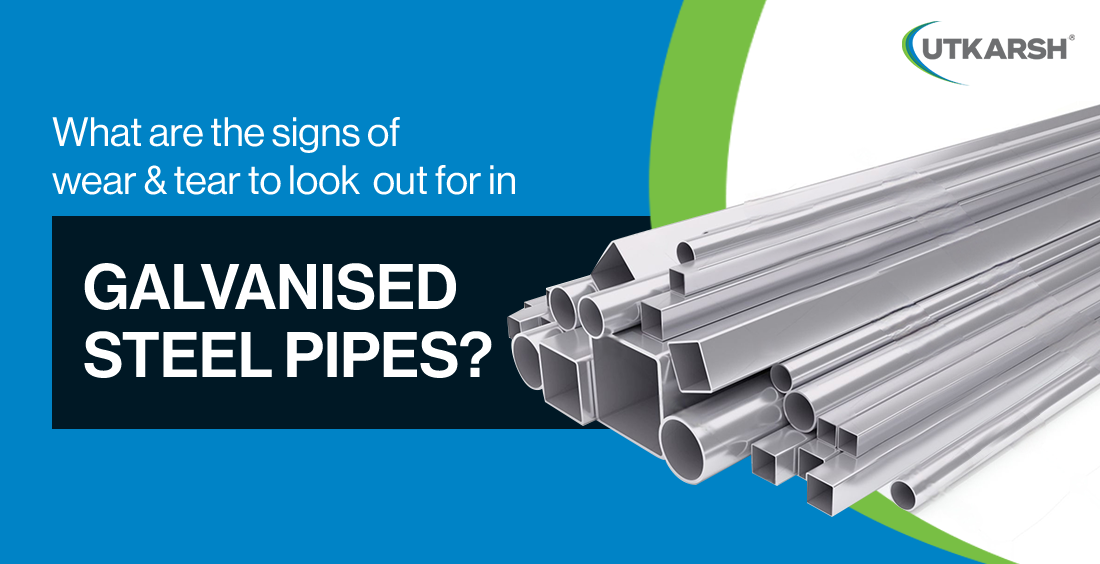What are the signs of wear and tear to look out for in galvanised steel pipes?

Galvanised steel pipes last for decades but can deteriorate over time. Corrosion, leaks, and blockages develop as the protective zinc layer wears away. Ignoring early signs leads to costly damage and unsafe water. Regular checks help detect issues before they worsen. Here, we discuss some of the key signs that indicate ageing or failing galvanised pipes.
1. Rust and corrosion
Galvanised steel pipes have a zinc coat that protects against rust. Over time, this coat can break down and expose the steel underneath. Moisture and oxygen then react with the steel, thereby forming rust. Rust weakens the pipes which can lead to leaks and blockages. It’s important to check pipes for reddish-brown patches, especially near joints and bends. If rust flakes off, the metal beneath will corrode faster. Corrosion spreads quickly once it begins, so early action remains important. External rust indicates problems, but internal rust causes bigger concerns. Internal corrosion restricts water flow, reduces pressure, and contaminates water. If left unchecked, rust can cause pipes to collapse or burst.
2. Discoloured water
Clean water should look clear. If water from taps appears brown, red, or yellow, rust is likely present inside the pipes. Rust mixes with water - it accuses discolouration that stains sinks, clothes, and appliances. Temporary discolouration may result from disturbances in the system. If the problem persists, corroded pipes are the likely cause. Replacing affected pipes improves water quality and prevents contamination. Water with visible particles suggests corrosion inside the pipes. These particles damage fixtures, clog appliances, and affect water quality. If rust appears in both hot and cold water, pipes may need urgent replacement.
3. Low water pressure
Water pressure should remain steady. A sudden drop indicates an issue within the plumbing system. Corrosion and mineral deposits build up inside pipes and reduce the passage for water flow. As the buildup increases, pressure declines. Low pressure affects daily tasks such as washing, cooking, and shower use. If pressure drops throughout the property, the main supply line may have corrosion. A pressure gauge can confirm if corrosion is the cause. If cleaning taps and showerheads does not restore pressure, pipe replacement may be necessary.
4. Leaks and damp patches
Leaks indicate significant wear in galvanised pipes. Corrosion weakens the metal and leads to small holes and cracks. These openings allow water to escape, which results in damp patches on walls, ceilings, or floors. Musty odours often suggest hidden leaks behind walls or under floors. Also, mold growth near pipes signals a persistent leak. Water stains on ceilings indicate leaks in overhead pipes. Even small leaks waste water and increase bills. Over time, leaks weaken the surrounding structure and cause costly damage.
5. Odd taste or smell in water
Rust inside pipes affects water quality and household safety. Corroded pipes release metal particles that alter taste and odour. Long-term exposure to metal-tainted water harms appliances and plumbing fixtures. A rotten egg smell signals sulphur bacteria inside the pipes. These bacteria thrive in stagnant water and release hydrogen sulphide gas. This gas creates an unpleasant odour and affects water safety. If the smell appears only in hot water, the water heater may be the source. If both hot and cold water have the same smell, corroded pipes likely cause the issue.
Testing water at multiple taps helps determine if contamination comes from internal pipes or the main supply. If only one tap shows signs of rust or odour, a localised issue exists. If all taps show contamination, pipe replacement may be necessary to ensure safe water quality.
Proper maintenance extends the life of galvanised steel pipes. Routine inspections help identify early signs of damage. Simple checks include:
- A close look at pipes for rust, leaks, and bulging
- Pressure tests to confirm steady water flow
- Listening for unusual noises in the system
- If pipes show multiple signs of deterioration, replacement may be necessary.
Quality matters when selecting steel pipes. A trusted manufacturer ensures durability, corrosion resistance, and compliance with industry standards. Poor-quality pipes fail faster, leading to leaks and costly repairs. Look for manufacturers with certifications, positive reviews, and a history of reliability. Established companies provide warranties and detailed specifications.
At Utkarsh India, we deliver top-quality steel pipes that meet international standards for strength, durability, and performance. With a strong reputation in the industry, we offer reliable solutions for diverse piping needs. With an annual production capacity of 1,40,000 MT, we continue to drive innovation.
We use advanced technology with a skilled workforce to manufacture ERW Black, and Galvanised Steel Pipes and Tubes. Our products serve multiple industries, including air and water lines, structural and fencing, fire sprinklers, borewells, boilers, heat exchangers, and general engineering.